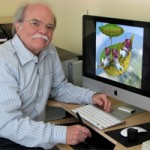When D. B. Johnson was a commercial illustrator, he was accustomed to tight deadlines. Creating a piece of art for the New York Times Book Review or the Los Angeles Times would take less than a week from initial assignment to idea to completed work. “I loved the intensity,” says Johnson. “I was afraid to think about a long-term assignment that lasted four or five months.” But in 1998, he had no illustration work scheduled because of a lull in the market. He cracked open the idea file he kept next to his drawing table and settled on a children’s story about one of his favorite authors, Henry David Thoreau.
As a student at Boston University, Johnson read Walden for the first time and became fascinated with Thoreau’s guide to simple living. Today, he reads Walden continuously, opening the book to random passages. Thoreau’s paradoxical thinking appeals to Johnson. “He takes the most outrageous things and makes them true,” Johnson says.
For instance, according to Thoreau, walking to Fitchburg will take less time than taking the train. Johnson began work on a manuscript that he titled Mr. Thoreau Takes a Walk. He wanted to cast Thoreau as an animal because animals are accessible to children and would tie-in to Thoreau and Johnson’s love of nature. Johnson also knew that Thoreau’s contemporaries thought of him as a magnanimous fox and a philosophical woodchuck. But the story didn’t coalesce until Johnson drew his Henry character as a bear. Renaming the story Henry Hikes to Fitchburg (Houghton Mifflin, 2000), Johnson trusted his new character to lead the way. “The stories come into my head,” says Johnson, “but Henry tells me what happens next.”
After the publication of Henry Hikes to Fitchburg, Johnson received the Ezra Jack Keats New Writer Award. Up until that point, he’d always approached his work from an illustrator’s point of view. “It changed my thinking a bit. It was the first time I thought about myself as a writer. It was a great feeling.”
Johnson writes about another Thoreau paradox in Henry Climbs a Mountain (Houghton Mifflin, 2003)—the idea that you must relinquish your own freedom to obtain greater freedom for others. In Johnson’s story, Henry is hauled off to jail for not paying his taxes because his state supports slavery. A long-time abolitionist, Thoreau spent time in jail for the same reason. According to Johnson, Henry Climbs a Mountain “fell into place when I added the mountain to the story.” Henry draws a mountain on his cell wall, climbing waterfalls and marching in and out of clouds. Johnson says, “I combined civil disobedience with Thoreau’s love of the mountains. [Henry’s] never confined even though he’s in jail.”
When Johnson thought about the illustrations for his Henry books, he rejected the idea of a historical biography on Thoreau. “I’m lifting from Thoreau, but I’m making it mine. . .I aimed for a present day energy—something that spoke to kids today.” Although the clothes and building in Johnson’s illustration indicate a historical context, Marc Chagall’s cubist style influences much of his art. Fractured pictures—the horizon lining up with Henry’s shoulders or people and objects slanted on the page—bring the reader’s attention into Johnson’s illustrations quickly.
In his next book, Eddie’s Kingdom (Houghton Mifflin, Fall 2005) Johnson has developed a new character that lives in an apartment building where everyone always fights. Eddie decides to draw a picture of everyone in the building. Based on another historical character that he’s keeping under wraps, Johnson says there’s a surprise at the end of the book.
Like Thoreau, Johnson begins each day with a walk in the woods. When all of his friends were buying expensive homes, Johnson and his wife sold their dream home for a condominium so he could continue illustrating. “The most important thing in life is to do the things you love,” he says. Johnson has chosen to keep his life simple to be prepared to take advantage of opportunities as they present themselves.
And the choice paid off. When Johnson turned to his idea file at the age of 55, Thoreau’s rules for simple living allowed him to pursue a new career writing children’s picture books. He’s never looked back. In his most recent book, Henry Works (Houghton Miffline, 2004), Johnson’s theme is that the best work can feel like play. He’s not only writing about it, he’s living it!


